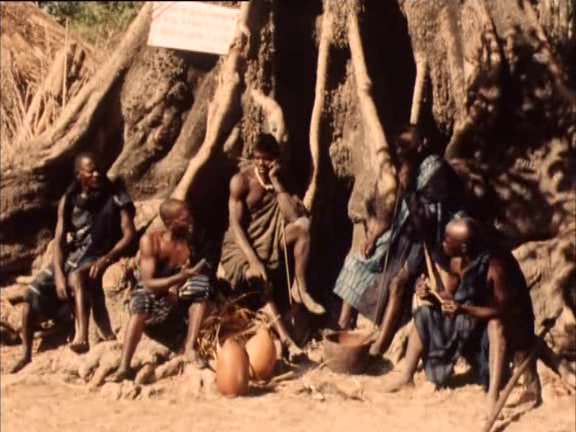I won’t be very good with details on this one – I was struggling to stay awake. Had no problems with Faat Kine though, which we watched next. Can’t say I liked this very much. Instead of blurrily remembering things about it, below are a bunch of quotes from other people.
One of the soldiers in charge, the commandant, was the main white actor in Black Girl.

Harvard:
Sembene’s third film launched his international reputation, reaching an audience far beyond Senegal’s Diola community, to whom he had directly addressed the film. Emitai takes place in the period at the end of the World War II, as West African veterans are returning to their homes in the French colonies. General De Gaulle, the hero of the trench resistance, is now the leader of the newly liberated France, yet forced conscriptions and massacres of Diola villages continue, some of them led by former members of France’s Vichy government. With Emitai, Sembene realized his statement “film should be a school of history.” When the film was released in 1971, it was immediately banned in Senegal, and throughout Africa.
WBAI’s explanation:
Sembene returns to village life in “Emitai.” It is in the early days of WWII and the French Vichy government is rounding up African youth to fight in their war. A village has been occupied by a company of native soldiers who are ordered about by a white Frenchman. Not one given to romanticism, Sembene depicts the lower-ranking African soldiers as passive servants of white rule.
Not satisfied with dragooning young men in a kind of neo-feudal tribute, the French demand rice as well to feed their army. With this demand, the villagers decide they have had enough. Not only is rice necessary for their physical survival, it is their link with their gods. Rice, like the rain that nourishes it, is sacred. To retain their links to the sacred, they hide the harvested rice from the soldiers.
In retaliation, the soldiers force the village women to sit in the brutal sun. They will only be released when the rice is turned over. In order to decide how to save themselves and their people, the village elders convene a series of meetings in a secluded altar to their gods beneath an enormous baobab tree. The gods, including Emitai, the god of thunder, instruct them to make sacrifices. So, in an obviously futile gesture, the elders sacrifice a rooster and then a goat, sprinkling the blood on the earth beneath the tree, after which the carcasses are heaved into a hollow in the trunk. Obviously there is an implied criticism of one aspect of traditional life by Sembene. Animism is no defense against French rifles.

From the NY Times:
The villagers don’t exactly need the rice; it is to be used in religious ceremonies, not for sustenance. And the French don’t really need it either. Halfway through the movie, deGaulle replaces Petain, the above-ground battles are ended, and so is the demand for overseas food. But everyone remains inflexible, and the story of “Emitai” continues to a fatal standoff in its bitter conclusion.
Just before the village chief dies—from French rifle wounds — he utterly renounces the gods, wherupon he is gotten up for a marvelous funeral, so he may rest with them in eternity. This juxtaposition is typical of the spirit “Emitai.”
It is a cool, balanced, proportionate spirit, affectionate but unillusioned, and wonderfully suited to the intricacies (and the idiosyncracies) of the subject matter. Sembene does not grab you; he engages you. Much of the time he photographs his action in the middle distance—not for the sake of distance but for the sake of an inclusiveness that keeps surprising you with its ironic sophistication.
“Emitai” isn’t a very complicated movie—in the abstract, little more than a tragic vignette. But for its purposes it is very complete; and considerate of the puzzles faced by its gods, its victims and its killers.
S. Axmaker likes it:
Emitai (1971) remains, to my mind, Sembene’s greatest masterpiece and his most important achievement. His angry attack on colonialism was inspired by the real life resistance of a Diola tribe who stood against the French soldiers that conscripted their men and took their rice during World War II. Sembene tosses out the conventions of western filmmaking and creates a style that arises from the storytelling traditions of rural Senegal. The contemplative pace, performances more ritual than realistic, and formal “call and response” dialogue create a world from the outside in, giving western audiences a culturally unique perspective and African audiences a sense of their own voice.